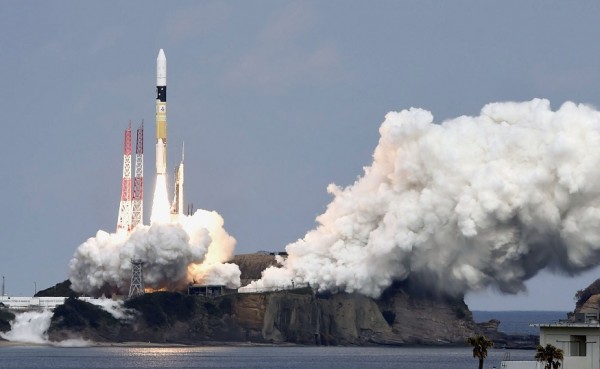Japan's Hayabusa-2 Launched; will Land Four Robots on a Comet
| Ana Verayo | | Dec 04, 2014 06:59 AM EST |
(Photo : Reuters) A H-IIA rocket carrying the Hayabusa-2 space probe blasts off from the Tanegashima Space Center.
The Japanese Aerospace Exploration Agency's newest asteroid probe, Hayabusa-2, was launched Wednesday, the first step in a mission that will last six years before it returns to Earth.
After the European Space Agency successfully landed its Philae robotic probe on Comet 67P/Churyumov-Gerasimenko, JAXA believes it will be equally successful with Hayabusa-2's asteroid mission.
Like Us on Facebook
Hayabusa-2 was mounted on an H-IIA rocket that blasted-off from JAXA's Tanegashima Space Center at 1:22 p.m. local time. The probe will use the Earth's gravitational forces as a slingshot to propel itself into deep space to begin its chase of Asteroid 1999JU3.
Hayabusa-2, which cost US$260 million to build, will spend 18 months studying the asteroid. It has a lifespan of six years and will reach the asteroid in 2018.It will return to Earth with samples from the asteroid in 2020.
Instead of latching itself onto the comet like Philae, Hayabusa-2 will fire small projectiles the asteroid to eject matter. This ejecta will enter the spacecraft's collector and stored in one of three chambers. These samples will be transferred to the spacecraft's reentry capsule for return to Earth.
JAXA described these projectiles as Hayabusa 2 as beanbags designed not to bounce upon impact, providing fixed reference points for landing attempts.
Hayabusa-2 is also carrying four small landers and an impactor. The Mobile Asteroid Surface Scout (MASCOT) is a German-built probe that will land on the asteroid to measure surface conditions using an infrared spectrometer, a magnetometer, a radiometer and a camera.
Hayabusa-2 will also deploy a group of MINERVA-II rover robots on the surface of the asteroid.
After completing its mission, the Hayabusa-2 will send back the asteroid samples to Earth. JAXA hopes to find organic molecules in this carbon rich asteroid that can reveal how life began in the solar system.
TagsJapan's Hayabusa-2 Asteroid Probe Launch Successful; Will Blow Up Asteroid for Samples, hayabusa 2, jaxa, JAXA japan asteroid probe hayabusa 2 successful launch
©2015 Chinatopix All rights reserved. Do not reproduce without permission
EDITOR'S PICKS
-

Did the Trump administration just announce plans for a trade war with ‘hostile’ China and Russia?
-

US Senate passes Taiwan travel bill slammed by China
-

As Yan Sihong’s family grieves, here are other Chinese students who went missing abroad. Some have never been found
-

Beijing blasts Western critics who ‘smear China’ with the term sharp power
-

China Envoy Seeks to Defuse Tensions With U.S. as a Trade War Brews
-

Singapore's Deputy PM Provides Bitcoin Vote of Confidence Amid China's Blanket Bans
-

China warns investors over risks in overseas virtual currency trading
-

Chinese government most trustworthy: survey
-

Kashima Antlers On Course For Back-To-Back Titles
MOST POPULAR
LATEST NEWS
Zhou Yongkang: China's Former Security Chief Sentenced to Life in Prison

China's former Chief of the Ministry of Public Security, Zhou Yongkang, has been given a life sentence after he was found guilty of abusing his office, bribery and deliberately ... Full Article
TRENDING STORY

China Pork Prices Expected to Stabilize As The Supplies Recover

Elephone P9000 Smartphone is now on Sale on Amazon India

There's a Big Chance Cliffhangers Won't Still Be Resolved When Grey's Anatomy Season 13 Returns

Supreme Court Ruled on Samsung vs Apple Dispute for Patent Infringement

Microsoft Surface Pro 5 Rumors and Release Date: What is the Latest?










